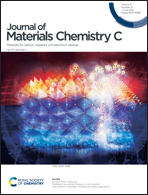Low in-plane atomic density phosphorene anodes for lithium-/sodium-ion batteries†
Abstract
Phosphorus anodes offer a high theoretical capacity for lithium-/sodium-ion batteries, but they suffer from serious expansion during charging, even when formed of 2D black phosphorene (α-P), which seriously affects their cycle reversibility. In this work, we systematically investigated a series of phosphorene anodes besides α-P for lithium-/sodium-ion batteries. β-P and γ-P with much lower in-plane atomic density are confirmed to be good substitutes for α-P. Both of them show moderate adsorption energy and low diffusion barriers, which ensure their high capacity and charging/discharging efficiency. Moreover, as β-P has a three-fold symmetrical lattice, the lithium/sodium adsorption and diffusion on it result in not anisotropic but equivalent in-plane expansion during charging, which should be beneficial to its integrity and reversibility. Furthermore, we discussed the conversion pathways from α-P to β-P, and from β-P to γ-P. The final activation barriers are 0.45 eV per atom and 0.52 eV per atom for the conversions from α-P to β-P, and from β-P to γ-P. Under strain induction, the transition barriers will drop significantly, and they are estimated to be 0.06 eV per atom for α-P to β-P, and 0.12 eV per atom for β-P to γ-P. These results can provide theoretical guidance and a reference for the experimental synthesis and application of these novel phosphorenes.



 Please wait while we load your content...
Please wait while we load your content...